Non-Programmable Thermostat
TSTATCCN(AC,HP,2S)01-C
Installation and Operating Instructions
NOTE: Read the entire instruction manual before starting the
installation.
This symbol → indicates a change since the last issue.
SAFETY CONSIDERATIONS
Read and follow manufacturer instructions carefully. Follow all
local electrical codes during installation. All wiring must conform
to local and national electrical codes. Improper wiring or installa-
tion may damage thermostat.
Recognize safety information. This is the safety-alert symbol
.
When you see this symbol on the equipment and in the instruction
manual, be alert to the potential for personal injury.
Understand the signal words DANGER, WARNING, and CAU-
TION. These words are used with the safety-alert symbol.
DANGER identifies the most serious hazards which will result
in severe personal injury or death. WARNING signifies a hazard
which could result in personal injury or death. CAUTION is used
to identify unsafe practices which would result in minor personal
injury or product and property damage. NOTE is used to highlight
suggestions which may result in enhanced installation, reliability,
or operation.
INTRODUCTION
Carrier thermostats are wall-mounted, low-voltage thermostats
which maintain room temperature by controlling the operation of
a heating and air conditioning system. Separate heating and
cooling setpoints, plus auto changeover provide maximum comfort
and flexibility. Batteries are optional; temperature and mode
settings are preserved with the power off.
INSTALLATION CONSIDERATIONS
Power
Note that all thermostats are dual powered where batteries can be
installed or in the presence of R and C (24vac) are not required. 2
AA batteries are furnished with the product.
Models
There are 3 different models. The 9th and 10th letters of the part
number indicate the model. These 2 letters also appear on the
package and on the circuit board. Be sure to have the proper
thermostat for the intended application. Models are:
AC — 1-stage cool, 1-stage heat for AC systems only.
HP — 1-stage cool, 2-stage heat for either HP, or AC with 2-stage
heat.
2S — 2-stage cool, 2-stage heat for 2-speed AC systems, or
2-stage cool, 3-stage heat for 2-speed HP systems.
Use each only for its intended purpose. See Table 1.
INSTALLATION
Step 1—Thermostat Location
Thermostat should be mounted:
• Approximately 5 ft. (1.5m) from floor.
• Close to or in a frequently used room, preferably on an inside
partitioning wall.
• On a section of wall without pipes or duct work.
Thermostat should NOT be mounted:
• Close to a window, on an outside wall, or next to a door leading
to the outside.
• Exposed to direct light and heat from a lamp, sun, fireplace, or
other temperature-radiating object which may cause a false
reading.
• Close to or in direct airflow from supply registers and return-air
grilles.
• In areas with poor air circulation, such as behind a door or in
an alcove.
Step 2—Select Model
AC Model (1-stage cool, 1-stage heat) is to be used for single-
stage heating and/or cooling applications only. It CANNOT be
used with optional outdoor temperature sensor. (See Table 1.)
HP Model (1-stage cool, 2-stage heat) can be used with a
single-speed heat pump (HP), or an air conditioner (AC) with a
2-stage furnace or fan coil. Software Option 5 selects HP/AC
operation. This thermostat comes configured from the factory as a
heat pump thermostat. Select AC in software Option 5 for AC
operation. When AC operation is selected, the O/W2 terminal is
converted from a reversing valve output (O) to a second-stage heat
output (W2). This output can be used to control 2-stage furnaces or
2-stage electric heat in fan coils. (See Table 1.)
2S Model is for 2-speed compressor systems only (HP and AC).
Output Y1 controls compressor low speed and output Y/Y2
controls compressor high speed. (See Table 1.)
HEIGHT (IN.) WIDTH (IN.) DEPTH (IN.)
3-1/2 5-3/4 1-3/8
Fig. 1—Carrier Non-Programmable Thermostat
TSTATCCNAC01-C
TSTATCCNHP01-C
TSTATCCN2S01-C
A04103
Visit www.carrier.com
Manufacturer reserves the right to discontinue, or change at any time, specifications or designs without notice and without incurring obligations.
Book
TabPC 101 Catalog No. 03TS-TA54 Printed in U.S.A. Form TSTAT-30SI Pg 1 08-04 Replaces: New

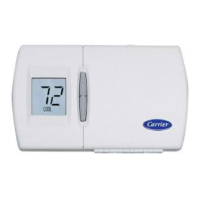


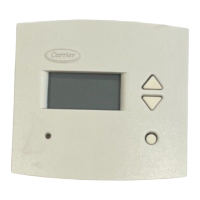
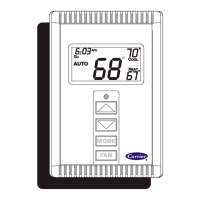
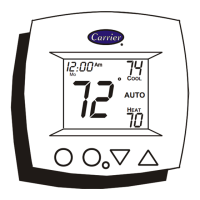




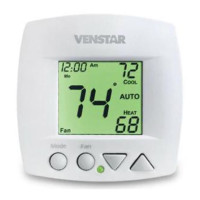
